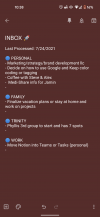Hi guys!
I am working forwards on my journey to implement GTD and I would like to upgrade my system (currently just using .txt files when learning instead of a program)
I am working on a Macbook and an android phone (The tool only needs to work on the Mac/web, I can use the phone just as an inbox)
Stuff I feel like I am missing right now are:
* Recurring tasks
* Setting start dates on tasks (instead of using my calendar as a tickler file)
* Connections between tasks and their projects (and maybe projects and areas of focuses? is that nice?)
There is also the reference materials, which I currently keep in a folder with some subfolders, I guess the tool could maybe help there as well, or that could be another tool in the future (like combining say Asana for "GTD lists" and Evernote for the reference materials)
Since getting active with GTD I've seen tons of tools:
The more popular ones it seems are:
Is there a good reason to pick one over the other? (Different strengths perhaps?) or do you have any other tips regarding which tool to pick?
What do you use and are you happy with that tool?
If I should pick 2 and use them for say 2 weeks each, which should I pick?
I am guessing some of the tools might be more complex than others (which could be both good and bad) - I would want more features than my pure text file approach, but I don't want to have to fill in lots of fields and stuff to just add a task, I guess I want to be able, but not be forced to link say a task to its project.
I am working forwards on my journey to implement GTD and I would like to upgrade my system (currently just using .txt files when learning instead of a program)
I am working on a Macbook and an android phone (The tool only needs to work on the Mac/web, I can use the phone just as an inbox)
Stuff I feel like I am missing right now are:
* Recurring tasks
* Setting start dates on tasks (instead of using my calendar as a tickler file)
* Connections between tasks and their projects (and maybe projects and areas of focuses? is that nice?)
There is also the reference materials, which I currently keep in a folder with some subfolders, I guess the tool could maybe help there as well, or that could be another tool in the future (like combining say Asana for "GTD lists" and Evernote for the reference materials)
Since getting active with GTD I've seen tons of tools:
- Asana
- Trello
- Todoist
- Things
- Nirvana
- Omnifocus
- Remember The Milk
- Evernote/One note
- Facilethings
- DevonThink
The more popular ones it seems are:
- Omnifocus
- Nirvana
- Things
- Todoist
Is there a good reason to pick one over the other? (Different strengths perhaps?) or do you have any other tips regarding which tool to pick?
What do you use and are you happy with that tool?
If I should pick 2 and use them for say 2 weeks each, which should I pick?
I am guessing some of the tools might be more complex than others (which could be both good and bad) - I would want more features than my pure text file approach, but I don't want to have to fill in lots of fields and stuff to just add a task, I guess I want to be able, but not be forced to link say a task to its project.

